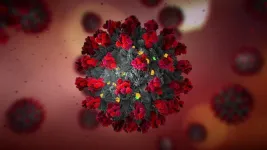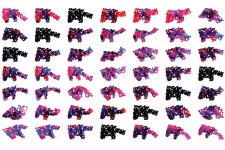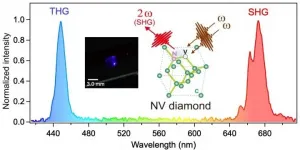INFORMATION:
Reactions is a video series produced by the American Chemical Society and PBS Digital Studios. Subscribe to Reactions at http://bit.ly/ACSReactions and follow us on Twitter @ACSReactions.
The American Chemical Society (ACS) is a nonprofit organization chartered by the U.S. Congress. ACS' mission is to advance the broader chemistry enterprise and its practitioners for the benefit of Earth and all its people. The Society is a global leader in promoting excellence in science education and providing access to chemistry-related information and research through its multiple research solutions, peer-reviewed journals, scientific conferences, eBooks and weekly news periodical Chemical & Engineering News. ACS journals are among the most cited, most trusted and most read within the scientific literature; however, ACS itself does not conduct chemical research. As a specialist in scientific information solutions (including SciFinder® and STN®), its CAS division powers global research, discovery and innovation. ACS' main offices are in Washington, D.C., and Columbus, Ohio.
To automatically receive news releases from the American Chemical Society, contact newsroom@acs.org.
Follow us: Twitter | Facebook | Instagram
Dog vs. machine: Who's a better bomb detector? (video)
2021-03-22
(Press-News.org) WASHINGTON, March 22, 2021 -- What's better at finding a hidden bomb -- a dog or an electronic chemical detector? In this episode, the Reactions team travels to the U.S. Naval Research Laboratory to find out: https://youtu.be/TRwqOFHOjac.
ELSE PRESS RELEASES FROM THIS DATE:
Majority of cancer patients with COVID-19 have similar immune response to people without cancer
2021-03-22
March 22, 2021 (BRONX, NY)-- Most people with cancer who are infected by the novel coronavirus produce antibodies at a rate comparable to the rest of the population--but their ability to do so depends on their type of cancer and the treatments they've received, according to a new study by researchers at Montefiore Health System and Albert Einstein College of Medicine. The findings, published online today in Nature Cancer, may lead to better care for cancer patients, who face a heightened risk of dying from COVID-19, and suggests that cancer patients should ...
Hormone drugs may disarm COVID-19 spike protein and stop disease progression
2021-03-22
PHILADELPHIA--Hormone drugs that reduce androgen levels may help disarm the coronavirus spike protein used to infect cells and stop the progression of severe COVID-19 disease, suggests a new preclinical study from researchers in the Abramson Cancer Center at the University of Pennsylvania and published online in Cell Press's iScience.
Researchers show how two receptors--known as ACE2 and TMPRSS2--are regulated by the androgen hormone and used by SARS-CoV-2 to gain entry into host cells. Blocking the receptors with the clinically proven inhibitor Camostat and other anti-androgen therapies prevented viral entry and replication, they also showed in lab studies.
The findings provide more insight into the molecular mechanisms of the virus but also support ...
Researchers' algorithm designs soft robots that sense
2021-03-22
There are some tasks that traditional robots -- the rigid and metallic kind -- simply aren't cut out for. Soft-bodied robots, on the other hand, may be able to interact with people more safely or slip into tight spaces with ease. But for robots to reliably complete their programmed duties, they need to know the whereabouts of all their body parts. That's a tall task for a soft robot that can deform in a virtually infinite number of ways.
MIT researchers have developed an algorithm to help engineers design soft robots that collect more useful information about their surroundings. The deep-learning algorithm suggests an optimized placement of sensors within the robot's body, allowing it to better interact with ...
Diamond color centers for nonlinear photonics
2021-03-22
Tsukuba, Japan - Researchers from the Department of Applied Physics at the University of Tsukuba demonstrated second-order nonlinear optical effects in diamonds by taking advantage of internal color center defects that break inversion symmetry of diamond crystal. This research may lead to faster internet communications, all-optical computers, and even open a route to next generation quantum sensing technologies.
Current fiber optical technology uses light pulses to transfer broad-bandwidth data that let you check your email, watch videos, and everything else on the Internet. The main drawback is that light pulses hardly interact with each other, so the information must be converted into electrical signals to allow your computer ...
Cells burn more calories after just one bout of moderate aerobic exercise, OSU study finds
2021-03-22
In a recent study testing the effects of exercise on overall metabolism, researchers at Oregon State University found that even a single session of moderate aerobic exercise makes a difference in the cells of otherwise sedentary people.
Mitochondria are the part of the cell responsible for the biological process of respiration, which turns fuels such as sugars and fats into energy, so the researchers focused only on mitochondria function.
"What we found is that, regardless of what fuel the mitochondria were using, there were mild increases in the ability to burn off the fuels," said Matt Robinson, lead author on the study and an assistant professor ...
Deluge of DNA changes drives progression of fatal melanomas
2021-03-22
Melbourne researchers have revealed how melanoma cells are flooded with DNA changes as this skin cancer progresses from early, treatable stages through to fatal end-stage disease.
Using genomics, the team tracked DNA changes occurring in melanoma samples donated by patients as their disease progressed, right through to the time the patient died. This revealed dramatic and chaotic genetic changes that accumulated in the melanoma cells as the cancers progressed, providing clues to potential new approaches to treating this disease.
The research, published in Nature Communications, was led by Professor Mark Shackleton, Professor Director of Oncology at Alfred Health and Monash University; Professor ...
Pain differs: Researchers unveil distinct neural circuits
2021-03-22
Clinically, multiple lines of evidence show that chronic pain and depressive symptoms are frequently encountered. Patients suffered from both pain and depression are likely to become insensitive to drug treatment, indicating a refractory disease. The neural mechanism under this comorbidity remains unclear.
In a study published in Nature Neuroscience, the research team led by Prof. ZHANG Zhi and Dr. LI Juan from the University of Science and Technology of China (USTC) of the Chinese Academy of Sciences (CAS), reported the discrete thalamocortical circuits underlying the pain symptom caused by tissue injury and depression-like states.
Being the gateway towards cerebral cortex and considered as the major source of 'nociceptive ...
Researchers use AI to estimate focal mechanism parameters of earthquake
2021-03-22
The research team led by Prof. ZHANG Jie from the University of Science and Technology of China (USTC) of the Chinese Academy of Sciences made progress on real-time determination of earthquake focal mechanism through deep learning. The work was published in Nature Communications.
Since there are connections between characteristics of the rupture surface of the source fault and seismic wave radiated by the source, it's vital to monitor the earthquake by immediate determination of the source focal mechanism which inferred from multiple ground seismic records.
However, it's hard to calculate the mechanism from the simple ...
Atomic techniques reveal the evolution of a bacterial protein
2021-03-22
A combination of an array of atomic-level techniques has allowed researchers to show how changes in an environment-sensing protein enable bacteria to survive in different habitats, from the human gut to deep-sea hydrothermal vents.
"The study gives us unprecedented atomic-level insight into how bacteria adapt to changing conditions," says Stefan Arold, professor of bioscience at KAUST. "To obtain these insights, we pushed the limits of three different methods of investigation and combined their results into a unified picture."
The histone-like nucleoid-structuring (H-NS) protein allows bacteria to sense changes in their environment, such as changes in temperature and salinity. Previously, the team had shown how the intestinal pathogen Salmonella typhimurium ...
Human fondness, faith in machines grows during pandemic
2021-03-22
People are not very nice to machines. The disdain goes beyond the slot machine that emptied your wallet, a dispenser that failed to deliver a Coke or a navigation system that took you on an unwanted detour.
Yet USC researchers report that people affected by COVID-19 are showing more goodwill -- to humans and to human-like autonomous machines.
"The new discovery here is that when people are distracted by something distressing, they treat machines socially like they would treat other people. We found greater faith in technology due to the pandemic and a closing of the gap between humans and machines," said Jonathan Gratch, senior author of the study and director for virtual humans research at the USC Institute for Creative Technologies.
The findings, which appeared recently ...







